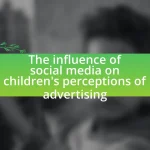The article examines the impact of children’s advertising on cognitive development, highlighting how exposure to marketing influences children’s understanding of consumer behavior, decision-making processes, and perceptions of reality. It discusses the cognitive skills affected by advertising, including attention, memory, and critical thinking, and emphasizes the role of various media platforms in shaping children’s exposure to ads. The article also addresses the long-term effects of advertising on children’s values and behaviors, the importance of media literacy for parents and educators, and strategies to mitigate negative impacts while fostering healthy cognitive growth.
What is the impact of children’s advertising on cognitive development?
Children’s advertising significantly influences cognitive development by shaping their understanding of consumer behavior and decision-making processes. Research indicates that exposure to advertising can enhance children’s ability to recognize brands and understand persuasive messaging, which can lead to increased materialism and altered perceptions of needs versus wants. A study published in the Journal of Consumer Research by John A. Bargh and others found that children exposed to advertisements are more likely to develop preferences for advertised products, demonstrating how advertising can directly affect their cognitive processing and consumer choices.
How does children’s advertising influence their thinking processes?
Children’s advertising significantly influences their thinking processes by shaping their perceptions, preferences, and decision-making skills. Research indicates that exposure to advertisements can lead children to develop brand loyalty at an early age, as they begin to associate certain products with positive emotions or social acceptance. For instance, a study published in the Journal of Consumer Research found that children aged 8 to 12 who were frequently exposed to advertisements exhibited a stronger preference for advertised brands over non-advertised ones, demonstrating how marketing can alter their cognitive evaluations of products. Additionally, children’s advertising often employs persuasive techniques, such as catchy jingles and colorful visuals, which can enhance memory retention and influence their understanding of needs versus wants. This manipulation of cognitive processes underscores the powerful role that advertising plays in shaping children’s consumer behavior and overall cognitive development.
What cognitive skills are affected by exposure to advertising?
Exposure to advertising affects several cognitive skills, including attention, memory, and critical thinking. Research indicates that children exposed to advertising often exhibit decreased attention spans due to the fast-paced and repetitive nature of ads, which can lead to difficulties in focusing on tasks. Additionally, memory can be impacted as children may remember brand names and slogans over important educational content, as shown in studies where children recalled advertisements more effectively than factual information. Furthermore, critical thinking skills may decline because advertising often promotes passive consumption rather than active analysis, limiting children’s ability to evaluate information critically. These findings highlight the significant influence of advertising on cognitive development in children.
How does advertising shape children’s perceptions of reality?
Advertising shapes children’s perceptions of reality by creating idealized images and narratives that influence their beliefs, desires, and understanding of the world. Research indicates that children, particularly those aged 2 to 7, are unable to critically evaluate advertisements, leading them to accept promotional messages as truth. For instance, a study published in the journal “Pediatrics” found that children exposed to food advertisements are more likely to prefer those products, regardless of their nutritional value. This manipulation of perception can result in skewed views on consumerism, body image, and social norms, as children often equate happiness and success with the products they see advertised.
Why is understanding this impact important for parents and educators?
Understanding the impact of children’s advertising on cognitive development is crucial for parents and educators because it directly influences children’s critical thinking, decision-making, and consumer behavior. Research indicates that exposure to advertising can shape children’s perceptions of reality and their understanding of social norms, which can affect their cognitive growth and emotional well-being. For instance, a study published in the Journal of Consumer Research found that children aged 8 to 12 who were frequently exposed to advertisements exhibited a higher tendency to materialism and a distorted understanding of needs versus wants. This knowledge empowers parents and educators to guide children in developing media literacy skills, enabling them to critically evaluate advertisements and make informed choices.
What are the potential long-term effects of advertising on children’s cognitive growth?
Advertising can significantly influence children’s cognitive growth by shaping their understanding of products, social norms, and decision-making processes. Research indicates that exposure to advertising can enhance materialistic values, leading to a focus on consumerism rather than intrinsic motivation or critical thinking skills. For instance, a study published in the Journal of Consumer Research found that children exposed to commercial messages are more likely to prioritize possessions over experiences, which can hinder their ability to develop deeper cognitive and emotional skills. Additionally, frequent exposure to advertisements can affect attention spans and increase impulsivity, as children learn to associate instant gratification with consumption. These long-term effects can ultimately shape their cognitive development and social interactions throughout their lives.
How can awareness of advertising’s impact guide parenting and teaching strategies?
Awareness of advertising’s impact can guide parenting and teaching strategies by enabling adults to critically evaluate and discuss media messages with children. This critical engagement helps children develop media literacy skills, allowing them to understand the persuasive intent behind advertisements. Research indicates that children aged 8 and under are particularly susceptible to advertising, often failing to recognize its persuasive nature (American Psychological Association, 2004). By fostering discussions about advertising, parents and educators can help children discern between entertainment and marketing, ultimately promoting healthier consumer habits and cognitive development.

What types of advertising are most prevalent among children?
The types of advertising most prevalent among children include television commercials, online ads, and product placements in children’s programming. Television commercials dominate, with studies indicating that children aged 2 to 11 view an average of 25 hours of television per week, exposing them to numerous ads. Online advertising, particularly through social media and gaming platforms, has also surged, with children frequently encountering targeted ads based on their interests and behaviors. Additionally, product placements in shows and movies aimed at children have become increasingly common, influencing their preferences and purchasing behaviors. Research from the American Psychological Association highlights that these advertising methods significantly impact children’s cognitive development and consumer behavior, shaping their understanding of products and brand loyalty from a young age.
How do different media platforms affect children’s exposure to advertising?
Different media platforms significantly influence children’s exposure to advertising by varying the frequency, format, and content of ads they encounter. Television, for instance, traditionally exposes children to a high volume of advertisements during programming aimed at younger audiences, with studies indicating that children can see over 20,000 commercials annually. In contrast, digital platforms like social media and mobile apps often employ targeted advertising strategies that utilize data analytics to deliver personalized ads, increasing the likelihood of engagement. Research from the American Academy of Pediatrics highlights that children are particularly susceptible to online advertising due to the interactive nature of digital media, which can lead to increased brand recognition and preference. Thus, the type of media platform shapes not only the quantity of advertising exposure but also the effectiveness of the ads on children’s cognitive development and consumer behavior.
What role do television, online content, and social media play in children’s advertising?
Television, online content, and social media serve as primary platforms for children’s advertising, significantly influencing their cognitive development. These mediums expose children to a vast array of advertisements that shape their preferences, behaviors, and understanding of consumer culture. Research indicates that children aged 2 to 11 are exposed to an average of 25 hours of television per week, leading to increased brand recognition and materialistic attitudes (American Academy of Pediatrics, 2016). Online content, including videos and games, further engages children, often incorporating interactive elements that enhance their receptiveness to advertising messages. Social media platforms, where children frequently interact, amplify this exposure, as advertisements are seamlessly integrated into their feeds, making them more relatable and persuasive. This multifaceted approach to advertising not only impacts children’s immediate purchasing decisions but also contributes to long-term cognitive patterns regarding consumption and brand loyalty.
How does the content of advertisements vary across different platforms?
The content of advertisements varies across different platforms primarily due to the audience demographics and engagement styles specific to each platform. For instance, social media platforms like Instagram and TikTok utilize visually engaging and short-form content to capture the attention of younger audiences, often featuring vibrant imagery and quick, catchy messages. In contrast, television advertisements tend to be longer and more narrative-driven, allowing for storytelling that can engage viewers emotionally, which is particularly effective for family-oriented products. Research indicates that children are more susceptible to advertisements that use animated characters and interactive elements, which are prevalent on digital platforms, compared to traditional media where such techniques are less common. This variation in content is crucial as it influences children’s cognitive development by shaping their perceptions and understanding of products differently based on the medium through which they are exposed.
What strategies do advertisers use to target children specifically?
Advertisers use various strategies to target children specifically, including the use of colorful visuals, catchy jingles, and characters that resonate with young audiences. These strategies are designed to capture children’s attention and create emotional connections, making products more appealing. For instance, studies show that advertisements featuring animated characters can significantly increase children’s recall of the product being advertised, as children are more likely to engage with content that includes familiar and entertaining figures. Additionally, advertisers often employ techniques such as product placement in children’s programming and interactive digital content to further enhance engagement and influence purchasing decisions.
How do emotional appeals in advertising influence children’s responses?
Emotional appeals in advertising significantly influence children’s responses by eliciting strong feelings that can affect their attitudes and behaviors towards products. Research indicates that advertisements utilizing emotional content, such as happiness, nostalgia, or fear, can enhance children’s engagement and recall of the advertised products. For instance, a study published in the Journal of Advertising Research found that children exposed to emotionally charged advertisements were more likely to express a desire for the product and remember the brand compared to those who viewed neutral advertisements. This demonstrates that emotional appeals can effectively shape children’s preferences and purchasing intentions, highlighting their impact on cognitive development in the context of advertising.
What techniques are used to create brand loyalty among young audiences?
Techniques used to create brand loyalty among young audiences include engaging storytelling, social media interaction, and influencer partnerships. Engaging storytelling captures the attention of young consumers by creating relatable narratives that resonate with their experiences and aspirations. Social media interaction fosters a sense of community and belonging, as brands actively engage with their audience through comments, shares, and user-generated content. Influencer partnerships leverage the trust and credibility that influencers have with their followers, making products more appealing to young audiences. According to a study by the American Psychological Association, children as young as eight can recognize brand logos and develop preferences, highlighting the effectiveness of these techniques in shaping brand loyalty early on.
How can the negative impacts of children’s advertising be mitigated?
To mitigate the negative impacts of children’s advertising, regulatory measures should be implemented to limit the exposure of children to misleading advertisements. Research indicates that children are particularly vulnerable to persuasive advertising techniques, which can lead to unhealthy consumption habits and distorted perceptions of reality. For instance, the American Psychological Association has highlighted that children under the age of eight cannot fully understand the persuasive intent of advertisements, making them susceptible to manipulation. Therefore, enforcing stricter guidelines on advertising content aimed at children, such as banning advertisements for unhealthy food during children’s programming, can significantly reduce their exposure to harmful marketing practices. Additionally, promoting media literacy programs in schools can empower children to critically evaluate advertisements, fostering a more discerning approach to media consumption.
What role do parents play in moderating children’s exposure to advertising?
Parents play a crucial role in moderating children’s exposure to advertising by actively managing their media consumption and discussing advertising content. Research indicates that parental mediation strategies, such as co-viewing and discussing advertisements, can significantly influence children’s understanding and interpretation of marketing messages. For instance, a study published in the Journal of Advertising Research found that children whose parents engage in discussions about advertisements are better equipped to critically analyze marketing tactics, leading to reduced susceptibility to persuasive advertising. This active involvement helps children develop critical thinking skills and fosters a more discerning approach to media, ultimately impacting their cognitive development positively.
How can parents educate their children about advertising tactics?
Parents can educate their children about advertising tactics by engaging them in discussions about the purpose and techniques of advertisements. This can include explaining how ads use persuasive language, appealing visuals, and emotional triggers to influence consumer behavior. Research indicates that children as young as 8 years old can recognize advertising strategies, but they may not fully understand their intent (Linn, 2004). By analyzing advertisements together, parents can help children identify these tactics and encourage critical thinking about the messages being conveyed. This approach not only enhances media literacy but also fosters an understanding of consumerism and its effects on cognitive development.
What practical steps can parents take to limit advertising exposure?
Parents can limit advertising exposure by implementing specific strategies such as monitoring and controlling screen time, utilizing ad-blocking software, and encouraging alternative activities. By setting limits on the amount of time children spend on screens, parents can reduce the likelihood of encountering advertisements, as studies show that increased screen time correlates with higher exposure to marketing messages. Additionally, using ad-blocking tools on devices can effectively prevent ads from appearing during online activities. Encouraging children to engage in non-screen-related activities, such as reading or outdoor play, further decreases their exposure to advertising, as research indicates that children who participate in diverse activities are less influenced by commercial messages.
What resources are available for educators to address advertising’s impact?
Educators can access various resources to address advertising’s impact on children’s cognitive development, including curriculum guides, research studies, and online platforms. For instance, the American Psychological Association provides guidelines and resources that help educators understand the effects of advertising on children. Additionally, the Center for Media Literacy offers educational materials that focus on media literacy, enabling students to critically analyze advertisements. Research such as “The Impact of Advertising on Children” by the American Academy of Pediatrics highlights the influence of advertising on children’s behavior and decision-making, providing educators with concrete evidence to support their teaching. These resources equip educators with the necessary tools to foster critical thinking and awareness among students regarding advertising’s effects.
How can schools incorporate media literacy into their curriculum?
Schools can incorporate media literacy into their curriculum by integrating lessons that focus on analyzing and evaluating media messages. This can be achieved through specific modules that teach students to critically assess advertisements, understand persuasive techniques, and recognize bias in media content. Research indicates that media literacy education enhances critical thinking skills and empowers students to make informed decisions about media consumption, which is crucial given the pervasive nature of advertising in children’s lives. For instance, a study by the Center for Media Literacy highlights that students who engage in media literacy programs demonstrate improved analytical skills and a greater understanding of the impact of advertising on their cognitive development.
What programs exist to help children critically analyze advertisements?
Programs that help children critically analyze advertisements include Media Smarts, a Canadian organization that provides resources for media literacy education, and the Admongo program, developed by the Federal Trade Commission in the United States, which teaches children to understand advertising techniques and develop critical thinking skills. Media Smarts offers lesson plans and activities that encourage children to evaluate media messages, while Admongo uses interactive games to engage children in recognizing persuasive advertising strategies. These programs are designed to enhance children’s ability to discern the intent behind advertisements and understand their influence, thereby contributing to their cognitive development in a media-saturated environment.
What are some best practices for fostering healthy cognitive development in children?
To foster healthy cognitive development in children, engaging them in interactive play and providing a rich language environment are essential practices. Interactive play, such as puzzles and games, stimulates problem-solving skills and creativity, while a language-rich environment, including reading aloud and conversations, enhances vocabulary and comprehension. Research indicates that children exposed to diverse vocabulary and complex sentences demonstrate improved cognitive abilities, as shown in studies by Hart and Risley (1995), which found that children from language-rich homes had significantly higher IQ scores by age three compared to those from less stimulating environments.
How can parents and educators create a balanced media environment?
Parents and educators can create a balanced media environment by establishing clear guidelines for media consumption and promoting diverse content. Setting limits on screen time, such as the American Academy of Pediatrics’ recommendation of no more than one hour of high-quality programming for children aged 2 to 5, helps ensure that media use does not interfere with healthy development. Additionally, encouraging the use of educational and age-appropriate content fosters cognitive growth, as studies show that children who engage with educational media demonstrate improved learning outcomes. By actively discussing media content with children, parents and educators can enhance critical thinking skills and help children differentiate between advertising and actual content, thereby mitigating the potential negative effects of children’s advertising on cognitive development.
What activities promote critical thinking skills in relation to advertising?
Activities that promote critical thinking skills in relation to advertising include analyzing advertisements, creating mock ads, and engaging in discussions about media literacy. Analyzing advertisements allows individuals to deconstruct the persuasive techniques used, such as emotional appeals and logical fallacies, fostering a deeper understanding of the intent behind the messages. Creating mock ads encourages participants to think critically about target audiences and the ethical implications of advertising strategies. Engaging in discussions about media literacy helps individuals recognize biases and evaluate the credibility of sources, which is essential in navigating the advertising landscape. These activities collectively enhance critical thinking by encouraging reflection, evaluation, and creativity in the context of advertising.






